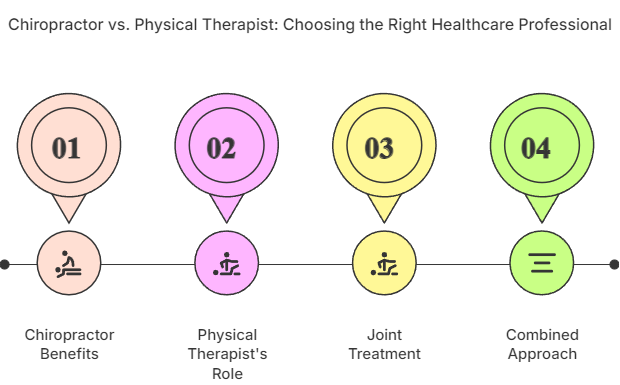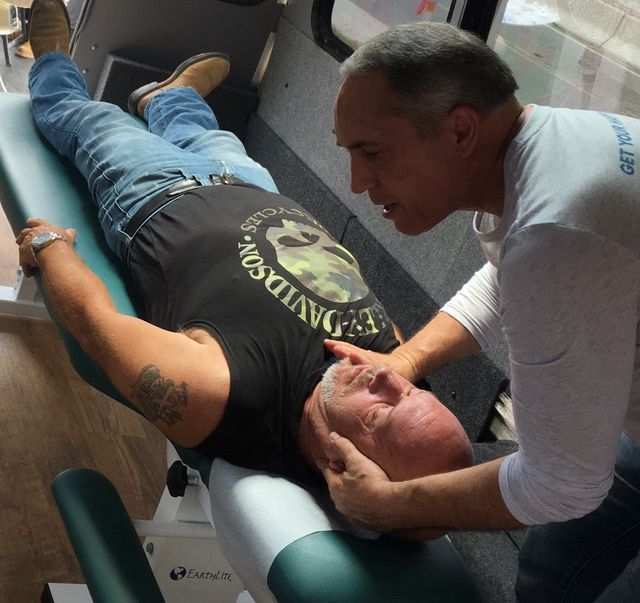Chiropractor vs Physical Therapist: Which One Do You Actually Need?
May 5, 2025
If you're dealing with pain, stiffness, or recovering from an injury, you've probably asked yourself: Should I see a chiropractor or a physical therapist? While both professionals help reduce pain and improve function, their approaches differ significantly. As someone who's worked at Crack Shack Chiropractic alongside physical therapists for years, I want to break down what sets these professions apart and help you figure out which one is right for your specific situation.
What's the Real Difference Between Chiropractors and PTs?
Chiropractors focus primarily on spinal alignment and the nervous system. We use manual adjustments to realign the spine and joints, relieving pressure on nerves and allowing your body to function better. Think of us as specialists in how your bones, joints, and nerves work together.
Physical therapists, on the other hand, are movement specialists who evaluate how your whole body functions. They concentrate on building strength, improving flexibility, and teaching proper movement patterns through targeted exercise programs. They're experts in rehabilitation and functional improvement.
Both professions aim to reduce pain and improve mobility without drugs or surgery, but our methods and focus areas differ significantly.

Education and Training: What Your Provider Studied
Chiropractor Education
Chiropractors complete a Doctor of Chiropractic (DC) degree after undergraduate studies. This intensive program takes about 4 years and includes deep study of anatomy, neurology, radiology, and spinal adjustments. We complete clinical rotations and must pass national board exams before receiving a license to practice.
Physical Therapist Education
Physical therapists earn a Doctor of Physical Therapy (DPT) degree, typically a 3-year program after undergraduate work. Their education emphasizes kinesiology, exercise physiology, and rehabilitation techniques. Like chiropractors, they must pass licensing exams and complete clinical education before practicing.
Both professions require continuing education to maintain licensure and stay current with best practices.
What to Expect During Treatment
A Typical Chiropractic Visit
When you visit a chiropractor, you'll usually receive hands-on treatment during your first visit. After discussing your symptoms and examining your spine and movement, we'll perform manual adjustments to correct misalignments. Many patients experience immediate relief, though complex cases may take several sessions.
Most appointments last 15-30 minutes, and treatment plans might start with 2-3 visits per week, decreasing as symptoms improve. We might also recommend stretches or exercises to support your adjustments.
A Typical Physical Therapy Visit
Physical therapy sessions are more active and typically longer (30-60 minutes). Your first visit will involve a thorough assessment of your movement, strength, and flexibility. The PT will develop a custom exercise program and may perform manual therapy to improve mobility.
You'll learn specific exercises to do both during sessions and at home. Progress happens gradually as you build strength and correct movement patterns over a course of weeks or months. Consistency with your home exercises dramatically affects your results.

When to Choose a Chiropractor vs. Physical Therapist
Chiropractors Excel at Treating:
- Acute back or neck pain, especially when it comes on suddenly
- Headaches related to neck tension or misalignment
- Joint pain and restricted movement
- Sciatica and nerve-related pain
- Pain that's preventing normal movement right now
If you need quick relief from pain that's stopping you from functioning normally, a chiropractor is often your best first stop.
Physical Therapists Are Ideal for:
- Rehabilitation after surgery or serious injury
- Rebuilding strength and function over time
- Balance and coordination issues
- Sports performance and injury prevention
- Chronic conditions requiring long-term management
If you're dealing with weakness, recovering from surgery, or need to relearn movement patterns, a physical therapist provides the structured program you need.
When You Might Need Both
Many patients benefit from combining these approaches. Starting with chiropractic care to address pain and alignment issues, then transitioning to physical therapy to build strength and prevent recurrence often provides optimal results. For complex conditions like chronic back pain, the combination can address both the structural and functional aspects of your pain.

Real Patient Examples
"Sarah" came to us after a car accident with severe neck pain and headaches. After four chiropractic sessions, her pain decreased by 80%, but she still felt unstable when turning her head. We referred her to physical therapy, where she learned exercises to strengthen her neck muscles and improve posture. The combination approach resolved her pain completely within two months.
"Mike" had recurring lower back pain for years. Physical therapy helped him develop core strength, but he continued to experience episodes of acute pain. Regular chiropractic adjustments helped maintain proper alignment while he built strength through PT exercises. This integrated approach gave him better results than either treatment alone.
Cost Considerations
Chiropractic visits typically cost $60-$100 per session but are usually shorter and may resolve acute issues in fewer visits. Physical therapy sessions cost $75-$150 and generally require a longer series of appointments to complete a rehabilitation program.
Insurance coverage varies widely. Some plans cover both services equally, while others may require referrals or have visit limitations. If you're paying out-of-pocket, ask about package pricing or cash discounts, as many practices offer these options.
How to Decide What's Best for You
Consider these factors when choosing between a chiropractor and physical therapist:
- Timeframe: Need immediate relief? Start with chiropractic. Looking for long-term rebuilding? Physical therapy might be better.
- Type of pain: Joint or nerve pain often responds well to chiropractic, while weakness or post-surgical recovery requires physical therapy.
- Previous results: If you've tried one approach without complete success, consider the other or a combined approach.
- Your participation preference: Chiropractic care is more passive (we do the adjustments), while physical therapy requires your active participation in exercises.
The most important factor may be finding a provider you trust who listens to your concerns and explains their approach clearly. A good practitioner in either field will refer you to the other profession when appropriate.

When to Consider Integrated Care
The healthcare landscape is evolving toward more collaborative approaches. Many clinics now offer both chiropractic and physical therapy services under one roof, allowing for coordinated care plans that leverage the strengths of each profession.
Consider asking your primary care provider for recommendations of practitioners who work collaboratively, or look for multidisciplinary clinics in your area.
Final Thoughts
There's no one-size-fits-all answer to whether you should see a chiropractor or physical therapist. Your specific condition, goals, and preferences all play important roles in determining the best approach.
Remember that both professions offer valuable, evidence-based approaches to pain management and functional improvement. Many patients find that a strategic combination provides the most comprehensive care.
At Crack Shack Chiropractic, we believe in giving you the full picture so you can make the best decision for your health. Whether you start with us or with a physical therapist, taking that first step toward feeling better is what matters most.








